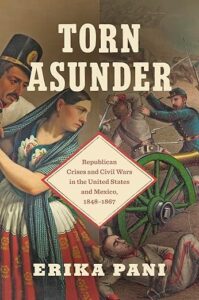Book Review: Torn Asunder: Republican Crises and Civil Wars in the United States and Mexico, 1848-1867
Torn Asunder: Republican Crises and Civil Wars in the United States and Mexico, 1848-1867. By Erika Pani. Chapel Hill, NC: The University of North Carolina Press, 2025. Paperback, 352 pp. $32.95.
Reviewed by Aaron Stoyack
Torn Asunder demonstrates the significant struggles faced by the two dominant North American republics in the mid-1800s. Both Mexico and the United States fought to redefine their country, not only against one another but also in subsequent wars. Secession and European imperialism threatened the very existence of these democracies, and both had to re-engage in nation-building even after the guns fell silent.
Torn Asunder adds to the growing body of scholarship comparing the U.S. and Mexico during the nineteenth century, alongside One National Family, Exceptionalism in Crisis, and other works released in the past year. This book is part of a series by UNC Press on New Borderlands History, showcasing the complexities of contested regions throughout eras.
Its author, Erika Pani, is a research professor at the Colegio de México, which allows her to encounter and engage with more Mexican and Spanish-language sources than other recent publications. She arranges the text chronologically by chapter. Subheaders highlight comparative challenges in both countries, such as legislating certain concepts and clashes between different ideologies.
Written for an academic audience, Torn Asunder assumes a degree of familiarity with major developments in Mexico during this time. As someone more familiar with this topic than most, I could follow along, but readers going in blind may struggle.
Pani grounds the conflicts from 1848 to 1867 in a global context, characterizing them alongside other reform wars from the 1848 revolutions in Europe to Japan’s Meiji Restoration. The first two chapters feature most of the border-region interactions between the two nations, highlighting the difficult transition of formerly Mexican areas to U.S. rule. From there, most of the discussion turns to developments at the federal and state levels.
A plurality of the text is devoted to these changes in the Mexican government. To that end, this book is a fantastic and incredibly in-depth resource. For those not ready to take that dive, One National Family or Alan Taylor’s American Civil Wars are much easier reads.
Civil War information is present but drowned out by Mexican political history. Pani devotes a chunk to the political angle of secession, engaging with and making frequent references to the works of Drew Gilpin Faust and Elizabeth Varon. Upon the dissolution of the Union, the Confederate States of America becomes a third entity entering the comparative ring. Chapter six, which focuses on economic policy, gives a healthy portion of seldom-discussed information on the Civil War, with talk of foreign trade, import duties, taxes, and industrialization. The next chapter briefly discusses diplomatic ventures between the Confederacy and Mexico, and the epilogue touches upon questions of prosecuting wartime adversaries (such as Jefferson Davis, and Mexicans who sided with the French).
Other tokens of Civil War knowledge are sprinkled throughout. American civilians and the transformation in their faith and how they thought about their future are other sizable sections. Battles themselves, even those fought during the Mexican-American War, find mention only when making a tangible impact on the bureaucratic scene.
Erika Pani delivered a stellar publication on comparative U.S. and Mexican political history. If you are looking for a purely political examination that covers all the bases, you cannot do any better.

